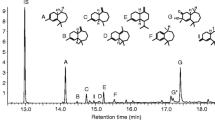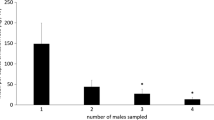Abstract
Six compounds previously identified from hindguts of unmated maleIps typographus (L.) during host colonization: 2-methyl-3-buten-2-ol (MB),cis-verbenol (cV),trans-verbenol (tV), myrtenol (Mt),trans-myrtanol (tM), and 2-phenylethanol (PE), were tested for their attractivity in the field with a subtractive method. The amounts of MB and cV released from a pipe trap were similar to those given off from the commercial bait Ipslure as well as that from a Norway spruce tree,Picea abies (L.) Karst., under mass attack. The blend of the compounds became nonattractive when either MB or cV was subtracted, while subtraction of any of the other four compounds had no effect. Addition of ipsdienol (Id) to the blend did not significantly increase the attraction. In a second comparative test, the addition of three compounds as a group (tV + Mt + PE) to MB + cV again had no effect on the attraction, but the addition of Id increased the catch somewhat. Addition of host logs to a bait releasing MB + cV at a rate lower than in previous experiments did not influence the attraction to pipe traps. Sticky traps containing natural pheromone sources (50 males in a log), which released 1–5 mg/day of MB as determined by aerations with deuterated MB as internal standard, were less attractive than a synthetic source releasing similar amounts of MB.
Similar content being viewed by others
References
Adlung, K.G. 1979. Versuchsergebnisse zur Anlockung des Buchdruckers (Ips typographus L.) mit Lockstoff-Dispensoren.Allg. Forst Jagdztg. 150:125–127.
Bakke, A. 1970. Evidence of a population aggregating pheromone inIps typographus (Coleoptera: Scolytidae).Contrib. Boyce Thompson Inst. 24:309–310.
Bakke, A. 1975. Aggregation pheromone in the bark beetle,Ips duplicatus (Sahlberg).Norw. J. Entomol. 22:67–69.
Bakke, A. 1976. Spruce bark beetle,Ips typographus: Pheromone production and field response to synthetic pheromones.Naturwissenschaften 63:92.
Bakke, A. 1981. Inhibition of the response inIps typographus to the aggregation pheromone; field evaluation of verbenone and ipsenol.Z. Angew. Entomol. 92:172–177.
Bakke, A., andRiege, L. 1982. The pheromone of the spruce bark beetleIps typographus and its potential use in the suppression of beetle population, pp. 3–15, in A.F. Kydonieus, and M. Beroza, (eds.). Insect Suppression with Controlled Release Pheromone Systems, Vol. II. CRC Press, Boca Raton, Florida.
Bakke, A., Frøyen, P., andSkattebøl, L. 1977. Field response to a new pheromonal compound isolated fromIps typographus.Naturwissenschaften 64:98.
Bakke, A., Saether, T., andKvamme, T. 1983. Mass trapping of the spruce bark beetleIps typographus. Pheromone and trap technology.Medd. Nor. Inst. Skogforsk. 38:1–35.
Bedard, W.D., Tilden, P.E., Wood, D.L., Silverstein, R.M., Brownlee, R.G., andRodin J.O. 1969. Western pine beetle: Field response to its sex pheromone and a synergistic host terpene, myrcene.Science 164:1284–1285.
Birgersson, G., Schlyter, F., Löfqvist, J., andBergström, G. 1984. Quantitative variation of pheromone components in the spruce bark beetleIps typographus from different attack phases.J. Chem. Ecol. 10:1029–1055.
Bombosch, S., Johann, M., andRamisch, G. 1982. Versuche zur Verbesserung der Fangsterbegnisse von Borkenkäferfallen.Holz-zentralblatt 129:1852–1853.
Borden, J.H., Lindgren, B.S., andChong, L. 1980. Ethanol and α-pinene as synergists for the aggregation pheromones of twoGnathotrichus species.Can. J. For. Res. 10:290–292.
Brand, J.M., Bracke, J.W., Markovetz, A.J., Wood, D., andBrowne, L. 1975. Production of verbenol by a bacterium isolated from bark beetles.Nature 254:136–137.
Byers, J.A. 1981. Effect of mating on terminating aggregation during host colonization in the bark beetle,Ips paraconfusus, J. Chem. Ecol. 7:1135–1147.
Byers, J.A., andWood D.L. 1980. Interspecific inhibition of the response of the bark beetles,Dendroctonus brevicomis andIps paraconfusus, to their pheromones in the field.J. Chem. Ecol. 6:149–164.
Byers, J.A., Lanne, B.S., Löfqvist, J., Schlyter, F., andBergström, G. 1985. Olfactory recognition of host-tree susceptibility by pine shoot beetles.Naturwissenschaften 72:324–326.
Dickens, J.C. 1981. Behavioural and electrophysiological responses of the bark beetle,Ips typographus, to potential pheromone components.Physiol. Entomol. 6:251–261.
Kirk, R.E. 1969. Experimental Design: Procedures for the Behavioural Sciences. Brooks/Cole, Belmont.
Klimetzek, D., andFrancke, W. 1980. Relationship between the enantiomeric composition of α-pinene in host trees and the production of verbenols inIps species.Experientia 36:1343–1344.
Krawielitzki, S., Klimetzek, D., Bakke, A., Vité, J.P., andMori, K. 1977. Field and laboratory response ofIps typographus to optically pure pheromonal components.Z. Angew. Entomol. 83:300–302.
Lanne, B.S.,Schlyter, F.,Byers, J.A.,Löfqvist, J.,Leufvén, A.,Bergström, G.,Van Der Pers, J.N.C.,Unelius, R.,Baeckström, P., andNorin, T. 1987. Difference in attraction to compounds similarly present in two sympatric pine shoot beetlesTomicus minor andT. piniperda. J. Chem. Ecol. In press.
Leufvén, A., Bergström, G., andFalsen, E. 1984. Interconversion of verbenols and verbenone by identified yeasts isolated from the spruce bark beetleIps typographus.J. Chem. Ecol. 10:1349–1361.
Peacock, J.W., Wright, S.L., andFord, R.D. 1984. Elm volatiles increase attraction ofScolytus multistratus (Coleoptera: Scolytidae) to multilure.Environ. Entomol. 13:394–398.
Pitman, G.B. 1971.Trans-Verbenol and alpha-pinene: Their utility in manipulation of the mountain pine beetle.J. Econ. Entomol. 64:426–430.
Regnander, J., andSolbreck, C. 1981. Effectiveness of different types of pheromone traps used againstIps typographus (L.) (Col., Scolytidae) in Sweden.Anz. Schaedlingskde Pflanz. Umweltschutz 54:104–108.
Renwick, J.A.A., andVité, J.P. 1969. Bark beetle attractants: Mechanism of colonization byDendroctonus frontalis.Nature 224:1222–1223.
Rudinsky, J.A., Novak, V., andSvihra, P. 1971. Pheromone and terpene attraction in the bark beetleIps typographus L.Experientia 27:161–162.
Sauerwein, P., andVité, J.P. 1978. Die Eignung von Typolur-Formulierungen zur Überwachung and Bekämpfung des BuchdruckerIps typographus.Mitt. Dtsch. Ges. Allg. Angew. Entomol. 1:189–192.
Schlyter, F., andCederholm, I. 1981. Separation of the sexes of living spruce bark beetles,Ips typographus (L.), (Coleoptera: Scolytidae).Z. Angew. Entomol. 92:42–47.
Schlyter, F., andLöfqvist, J. 1986. Response of walking spruce bark beetlesIps typographus to natural pheromone from different attack phases.Entomol. Exp. Appl. 41:219–230.
Schlyter, F.,Byers, J.A., andLöfqvist, J. 1987. Attraction to pheromone sources of different quantity, quality and spacing: Density-regulation mechanisms in the bark beetleIps typographus.J. Chem. Ecol. In press.
Vaupel, O., Dimitri, L., andVité, J.P. 1981. Untersuchungen über den Einsatz von Lockstoffbeköderten Rohrfallen zur Bekämpfung des Buchdruckers (Ips typographus L.), sowie Möglichkeiten der Optimerung von Lockstoffverfahren.Allg. Forst. Jagdztg. 152:102–113.
Vité, J.P., Bakke, A., andRenwick, J.A.A. 1972. Pheromones inIps (Coleoptera: Scolytidae): Occurrence and production.Can. Entomol. 104:1967–1975.
Wood, D. 1982. The role of pheromones, kairomones, and allomones in the host selection and colonization behavior of bark beetles.Annu. Rev. Entomol. 27:411–446.
Author information
Authors and Affiliations
Additional information
Coleoptera: Scolytidae.
This study was made within the Swedish project “Odour Signals for Control of Pest Insects.”
Rights and permissions
About this article
Cite this article
Schlyter, F., Birgersson, G., Byers, J.A. et al. Field response of spruce bark beetle,Ips typographus, to aggregation pheromone candidates. J Chem Ecol 13, 701–716 (1987). https://doi.org/10.1007/BF01020153
Received:
Accepted:
Issue Date:
DOI: https://doi.org/10.1007/BF01020153




